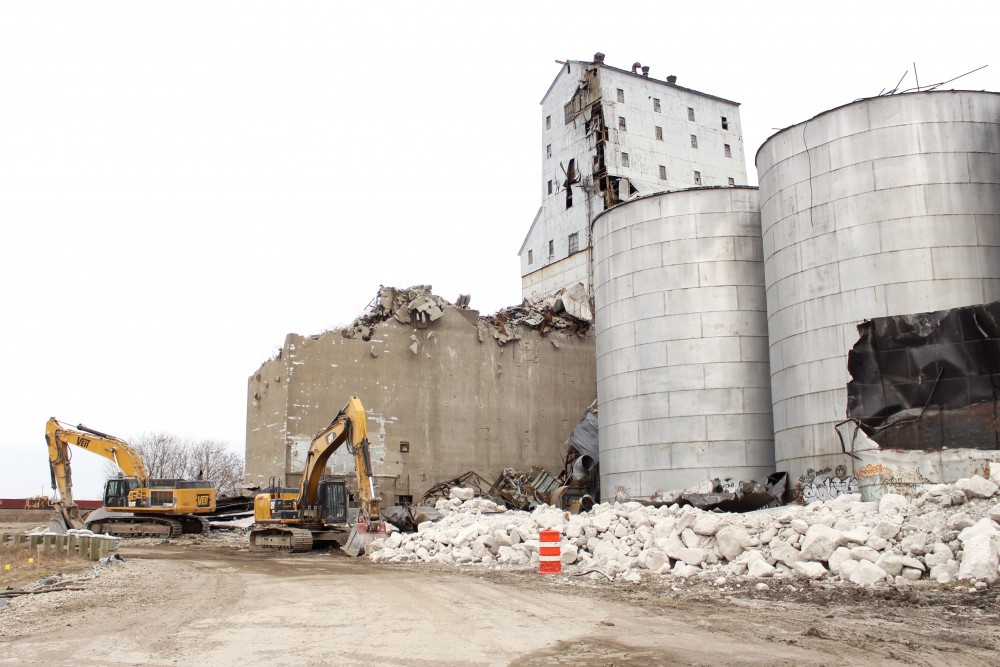The University of Minnesota is proceeding with the demolition of the Electric Steel elevators near TCF Bank Stadium despite legal attempts to halt the process.
Demolition of the elevators began last month, even with an ongoing legal dispute with the Friends of the Electric Steel Elevators, LLC — a group trying to preserve the structure, which they claim is historic.
The elevators are being torn down to make way for the Recreational Sports Bubble, which will be displaced by the construction of a new track and field facility.
Erik Hansen, attorney for the Friends of the Electric Steel elevators, said the city of Minneapolis has protections for historic buildings, but the University argued it is autonomous from the state and city codes don’t apply. Still, the electric elevators never got city historic designation.
The group argued that, as a state entity, the University must cooperate with other state agencies like the Minnesota Historical Society.
The lawsuit claims the Electric Steel Elevators are the last of their kind in Minnesota and have historical significance because they embody a time when Minneapolis was the milling capitol of the world.
The University’s Board of Regents voted 11-1 in November to demolish the buildings, even after many community members voiced their opposition.
Eric Amel, secretary of the Prospect Park Association, previously told the Minnesota Daily the school’s choice to demolish the buildings raised concerns about the school’s autonomy from the state.
In an interview Friday, Amel said the University is operating within the bounds of the law, but that “They’re wrong. They’re just wrong.”
Hansen said while the University has the legal right to proceed, he’s frustrated the school decided to move forward with the lawsuit still pending.
“This is part of the issue in preservation cases where you have a developer … with a great deal of monetary resources that are intent on destroying something,” he said. “The ability to put that on hold is very limited.”
Dan Herber, a University attorney, said both parties asked the court to make a ruling by April 26, though both Herber and Hansen said they expect a ruling any day.
Friends of the Electric Steel Elevators filed a temporary restraining order in December to halt demolition, but it was rejected.
Herber said after the group served a complaint in October, the University voluntarily withheld going forward with demolition until the court decided to reject the group’s restraining order. They’ve started demolition now to meet the regents’ timeline.
If the court rules in favor of the group, an injunction will be granted and demolition will have to stop. Large portions of the buildings have already been destroyed.
It will cost the school just over $3 million to demolish the buildings, funded with University debt. The cost was upped by $1.8 million when asbestos was found at the site.
In total, the University will spend $19 million to build the new track and field facility, relocate the sports bubble and construct a new softball field at the site.
In an email statement, Interim Vice President for University Services Mike Berthelsen said the school plans to finish the demolition this spring.
“It’s important to note that demolition at this time will allow the University to keep its commitment to the students to have the recreational dome and fields completed by November 2017 as well as to keep the … Track and Field project on schedule,” the statement said.
Regent Michael Hsu said the University has already spent significant time and money trying to find ways to use the structure, but ultimately the school has a better use for the land.
“Autonomy is autonomy,” he said. “We’re in higher ed. We don’t have money. We’re fighting for every dollar we have. And I think we’ve spent a fair amount of resources trying to accommodate people by not tearing it down sooner.”
He said the school is lucky urban explorers haven’t died in the elevators, adding from a liability perspective they should have been torn down long ago.
“The fact that we didn’t — we’re just lucky that nothing bad has happened,” he said.
Demolition is expected to end in July, and the sports bubble is expected to be relocated by November.













